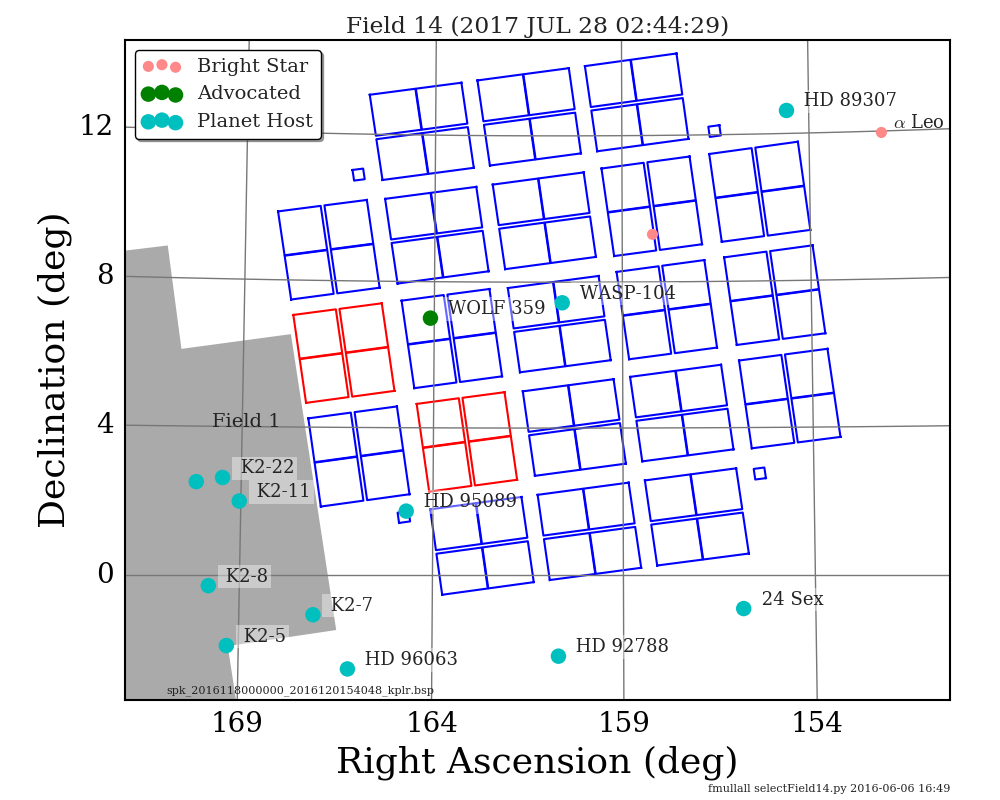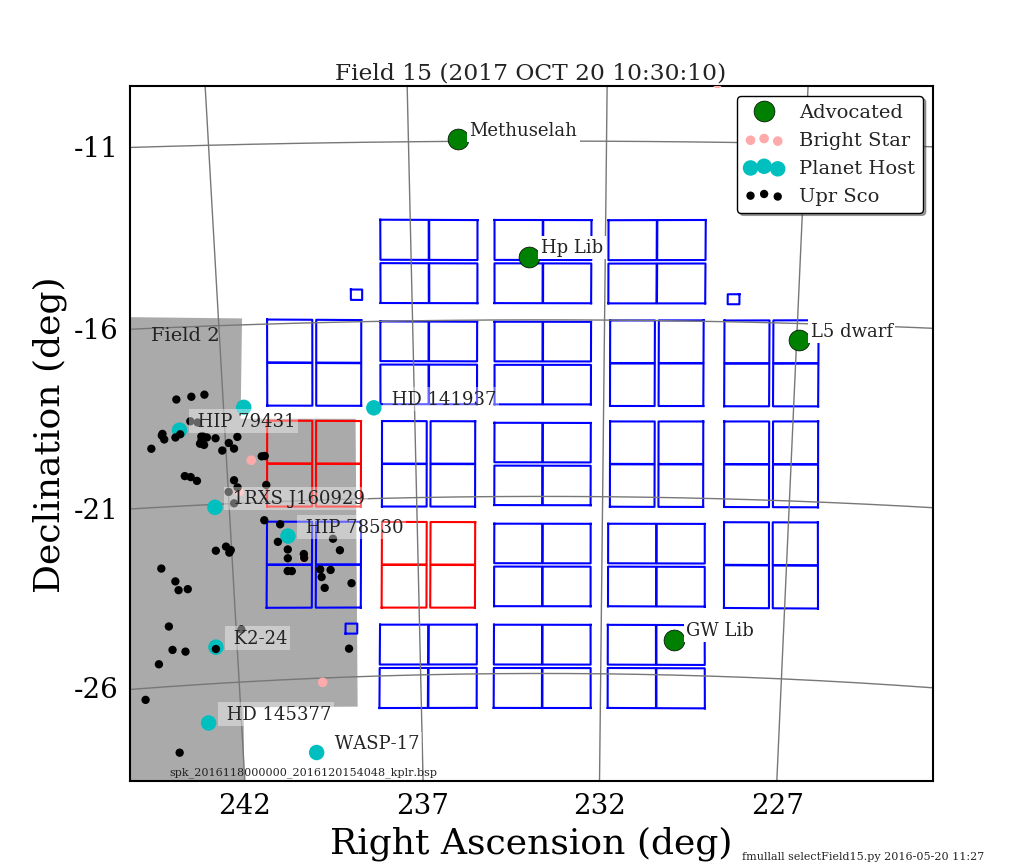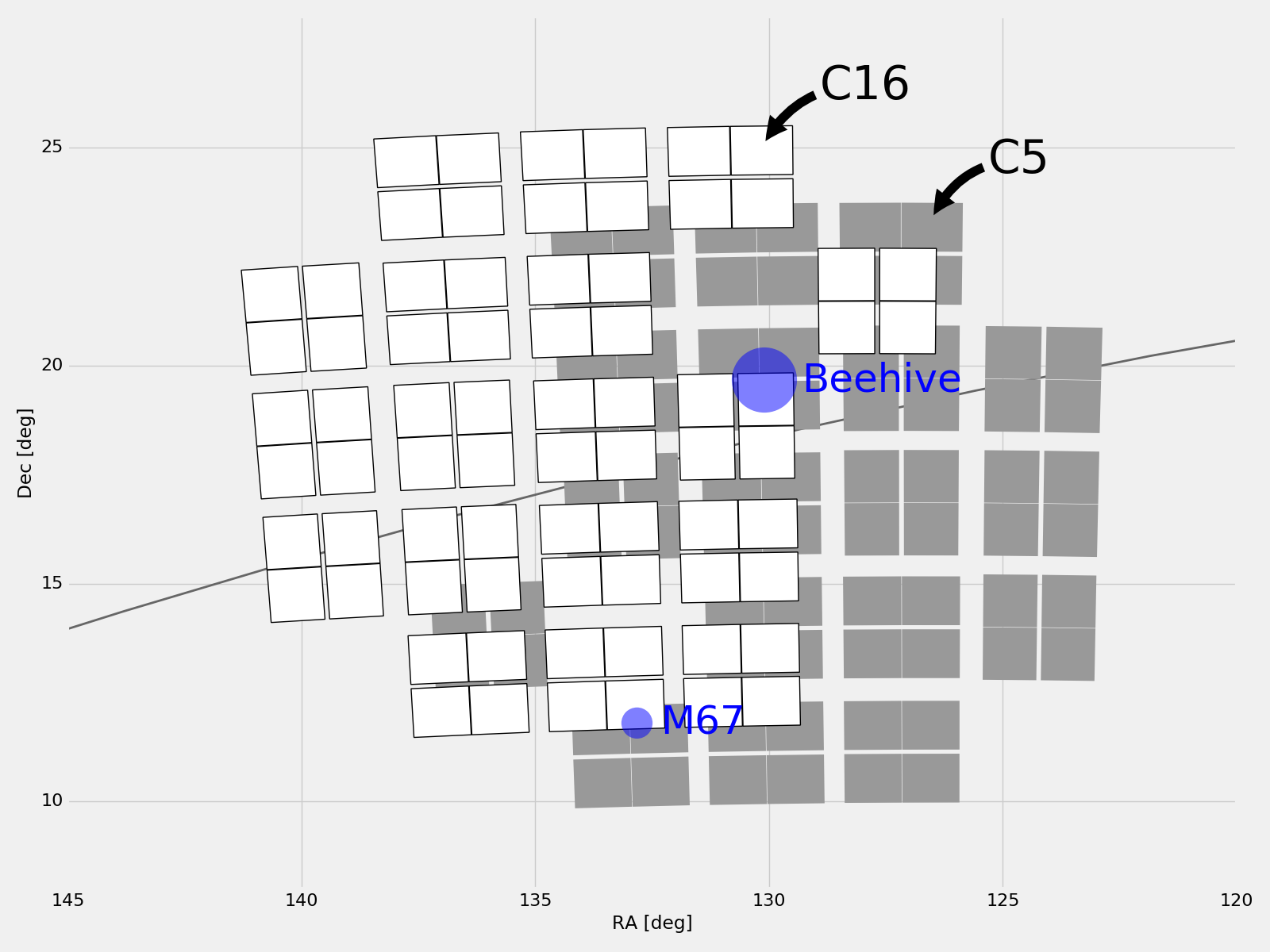Proposals for targets to be observed by K2 in Campaigns 14, 15, and 16 are currently being solicited as part of K2 Guest Observer Cycle 5, with Step 1 submissions due on November 3, 2016.
The fields of these campaigns will cover roughly 100 square degrees each towards the constellations of Leo (C14), Libra (C15), and Cancer (C16). To help inspire observing proposals, this post offers a list of notable targets that will be visible during these campaigns.
Campaign 14
Field 14 (RA 11h, Dec +7°) is located at a moderately high Galactic Latitude (+50°) towards the constellations of Leo and Sextans.
Notable targets include:
- Leo I Group: a group of nearby, bright galaxies that lie within the Local Supercluster. Its members include M95, M96, and M105.
- WASP-104: a bright G-type star known to host a transiting hot Jupiter. (V=11)
- Wolf 359: a very nearby (2.4pc) late-M dwarf, known to show flares. (V=14)
- BD+01 2447: a nearby M dwarf member of the AB Doradus moving group. (V=10)
- ρ Leo: a bright B-type supergiant. (V=4)
- Asteroid Toutatis: a potentially hazardous asteroid that has been visited by the Chinese Chang'e 2 probe. (V=19)
- Comet 61P/Shajn-Schaldach: a faint periodic comet. (V=22)
Campaign 15
Field 15 (RA 16h, Dec -20°) is located at a moderate Galactic Latitude (+30°) towards the constellation of Libra. There is a small overlap with the previous Campaign 2.
Notable targets include:
- Upper Sco: a young, nearby OB association that was previously observed during C2. It is partially visible again in C15. Notable Upper Sco members that are visible in C15 include:
- HIP 78530: a B-type star known from direct imaging to contain a planet or brown dwarf companion. (V=7)
- δ Sco: a bright, B-type binary. (V=2)
- 33 Lib: a bright roAp-type star. (V=7)
- HD 134439 & HD 134440: a metal-poor proper motion pair. (V=9)
- NGC 5897: a distant, 12 Gyr-old globular cluster.
- Asteroid Ryugu: a near-Earth asteroid, scheduled to be visited by the Hayabusa 2 sample-return mission in 2018. (V=20)
- Asteroid Gaspra: a main belt asteroid visited by the Galileo spacecraft in 1991. (V=16)
- Comet C/2014 W2: a long-period comet. (V=18)
Campaign 16
Field 16 (RA 9h, Dec +19°) is located at a moderate Galactic Latitude (+35°) towards the constellation of Cancer. About 30% of the field overlaps with the previous Campaign 5.
The field shows very low foreground extinction (Av ~0.2 mag) which makes it well-suited for extragalactic and supernova science. This field will be observed in the spacecraft's forward-facing direction, enabling simultaneous observations to be made from the ground at the cost of having the bright Earth pass through the field.
Notable objects include:
- M44 (aka Praesepe or the Beehive): a 600 Myr-old open cluster revealed by K2 Campaign 5 to contain several planets.
- M67: a famous, 4 Gyr-old open cluster.
- K2-34: a known exoplanet host revealed by K2 Campaign 5. (V=11)
- Arkushanangarushashutu: a bright K-type giant, famous for being the star with the longest name. (V=4)
Other candidate highlights
In addition to the highlights listed above, Simbad lists a wealth of known objects that will be visible during these Campaigns. They include:
- 19208 Galaxies;
- 6993 Quasars;
- 1904 M-type stars;
- 868 High Proper-Motion stars;
- 820 Active Galactic Nuclei;
- 533 Planetary Nebulae;
- 515 White Dwarfs;
- 511 RR Lyr Variables;
- 296 Symbiotic Stars;
- 131 Brown Dwarfs;
- 75 Blue Stragglers;
- 64 Cepheids
- 28 T Tauri Stars;
- 22 Cataclysmic Variables;
- 16 Mira Variables;
- 3 O-type stars.
A full table containing all Simbad sources that are visible in C14-15-16 can be downloaded from this website in CSV format (K2-C14-C16-Simbad.csv) or as a VOTable (K2-C14-C16-Simbad.xml.gz). Beware however that Simbad is not a full catalog of all known sources; it merely lists objects that have previously been discussed in the literature. For the purpose of e.g. color-based target selections, we recommend using a more complete source catalog, preferably the EPIC catalog.
As a reminder, the K2fov Python package enables you to test whether targets fall within a campaign field, while its sister K2ephem package allows moving Solar System bodies to be checked. Note that it is crucial to use K2fov version 6.0 or higher for Campaigns 14-15-16.



